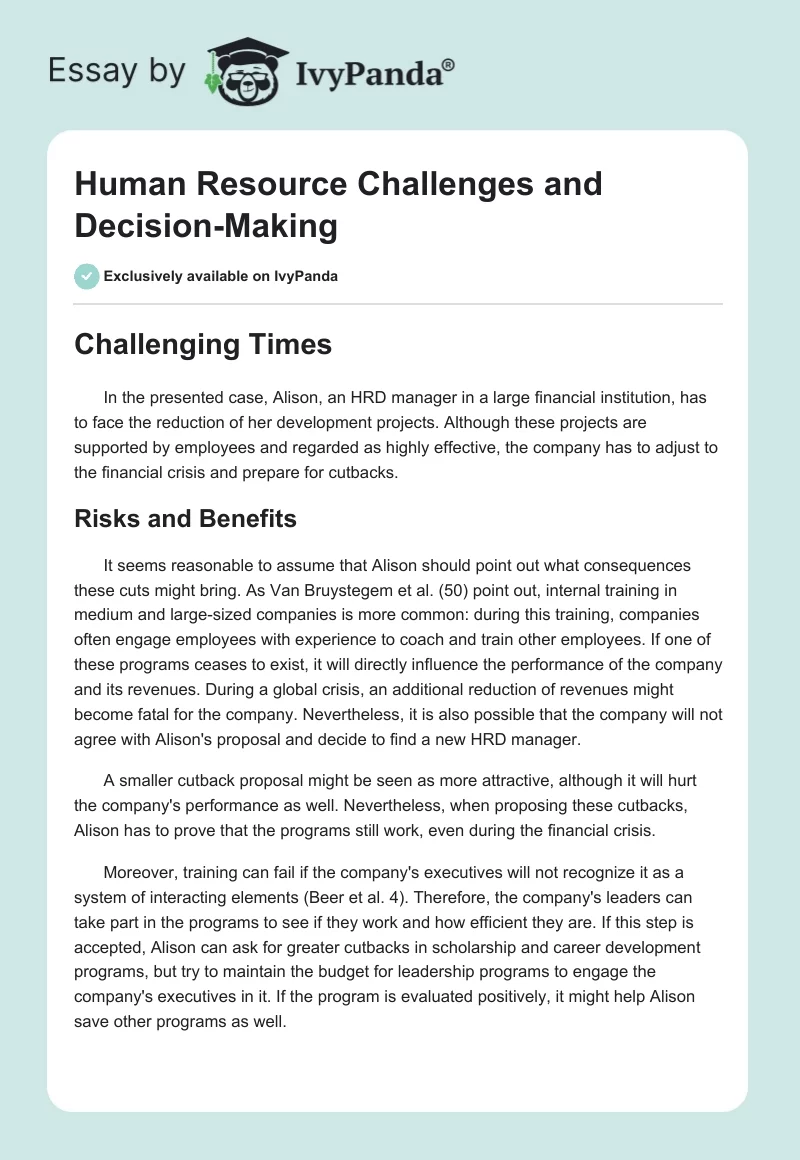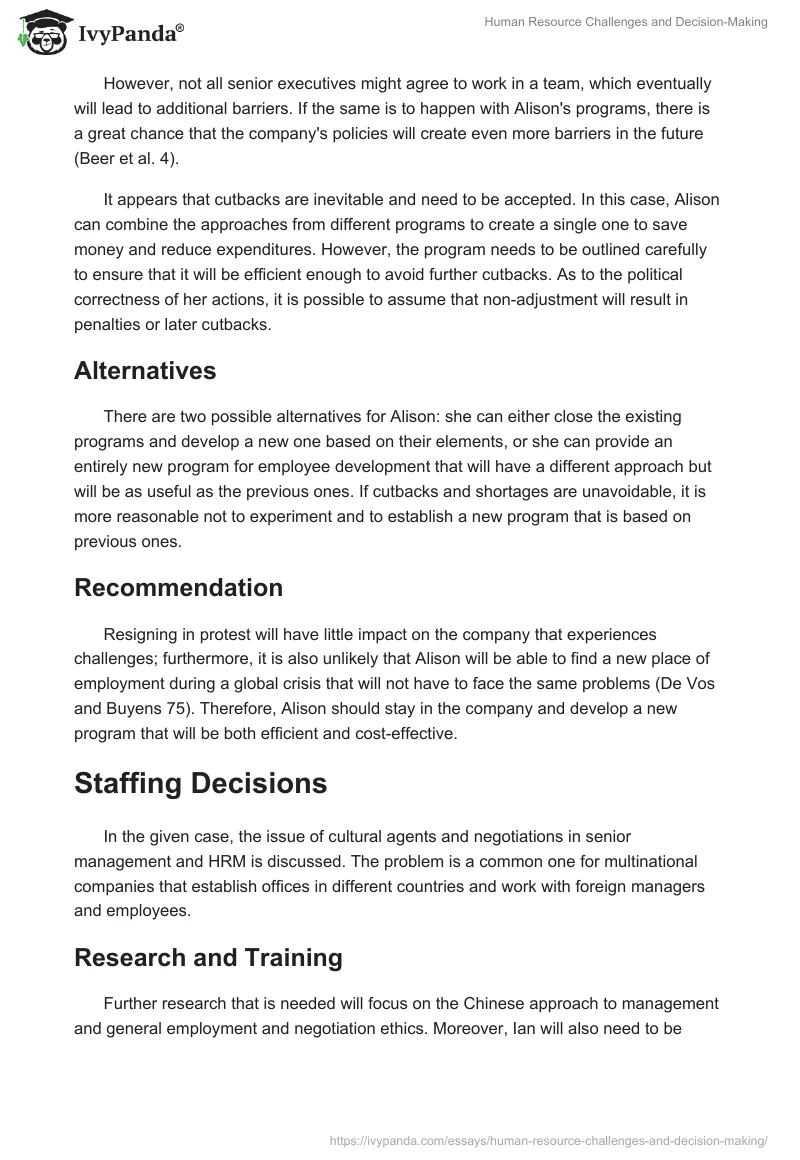Challenging Times
In the presented case, Alison, an HRD manager in a large financial institution, has to face the reduction of her development projects. Although these projects are supported by employees and regarded as highly effective, the company has to adjust to the financial crisis and prepare for cutbacks.
Risks and Benefits
It seems reasonable to assume that Alison should point out what consequences these cuts might bring. As Van Bruystegem et al. (50) point out, internal training in medium and large-sized companies is more common: during this training, companies often engage employees with experience to coach and train other employees. If one of these programs ceases to exist, it will directly influence the performance of the company and its revenues. During a global crisis, an additional reduction of revenues might become fatal for the company. Nevertheless, it is also possible that the company will not agree with Alison’s proposal and decide to find a new HRD manager.
A smaller cutback proposal might be seen as more attractive, although it will hurt the company’s performance as well. Nevertheless, when proposing these cutbacks, Alison has to prove that the programs still work, even during the financial crisis.
Moreover, training can fail if the company’s executives will not recognize it as a system of interacting elements (Beer et al. 4). Therefore, the company’s leaders can take part in the programs to see if they work and how efficient they are. If this step is accepted, Alison can ask for greater cutbacks in scholarship and career development programs, but try to maintain the budget for leadership programs to engage the company’s executives in it. If the program is evaluated positively, it might help Alison save other programs as well.
However, not all senior executives might agree to work in a team, which eventually will lead to additional barriers. If the same is to happen with Alison’s programs, there is a great chance that the company’s policies will create even more barriers in the future (Beer et al. 4).
It appears that cutbacks are inevitable and need to be accepted. In this case, Alison can combine the approaches from different programs to create a single one to save money and reduce expenditures. However, the program needs to be outlined carefully to ensure that it will be efficient enough to avoid further cutbacks. As to the political correctness of her actions, it is possible to assume that non-adjustment will result in penalties or later cutbacks.
Alternatives
There are two possible alternatives for Alison: she can either close the existing programs and develop a new one based on their elements, or she can provide an entirely new program for employee development that will have a different approach but will be as useful as the previous ones. If cutbacks and shortages are unavoidable, it is more reasonable not to experiment and to establish a new program that is based on previous ones.
Recommendation
Resigning in protest will have little impact on the company that experiences challenges; furthermore, it is also unlikely that Alison will be able to find a new place of employment during a global crisis that will not have to face the same problems (De Vos and Buyens 75). Therefore, Alison should stay in the company and develop a new program that will be both efficient and cost-effective.
Staffing Decisions
In the given case, the issue of cultural agents and negotiations in senior management and HRM is discussed. The problem is a common one for multinational companies that establish offices in different countries and work with foreign managers and employees.
Research and Training
Further research that is needed will focus on the Chinese approach to management and general employment and negotiation ethics. Moreover, Ian will also need to be acquainted with the cultural agents (such as traditions, rules, beliefs, moral values, etc.) of China to evaluate how they will influence the company’s work in this country.
Extensive training is necessary to prepare managers to take up positions. However, as this training will include language courses as well, it might take several years to become fluent in Mandarin or Cantonese. Thus, it is more reasonable to hire Chinese professionals who do not require such training. During relocation, the company will need to provide dwelling units for employees, cover their frequent flights if necessary, and ensure that employees’ families can travel with them. However, not all employees might agree to move to a new country with their families when nobody is fluent in the country’s language.
Advantages and Disadvantages
The greatest advantages of hiring Chinese professionals would be their understanding of the market, their language skills, and general experience of working with Chinese customers. The disadvantages can include the autonomous power of Chinese managers who might not agree with all policies because they will see these policies as inefficient (Van Bruystegem et al. 49). This, in return, will influence employees’ performance and twist the company’s image.
Combination of Managers
A combination of Chinese and Australian managers is a solution that will address both the problem of autonomy and commitment to the company. However, both the general manager and business development manager should be Chinese because these duties require an in-depth understanding of Chinese culture, government, and business relations. Factory manager can be an Australian one but only with specific training and excellent command of the Chinese language. Furthermore, Chinese managers will need to understand the Western approach to business as well.
The obvious disadvantage is the senior group’s possible lack of commitment. As Beer et al. point out, “the senior team clearly defines values and an inspiring strategic direction” (4). Since these managers are new to the company’s values and strategic direction, it will be difficult for them to define these. However, an Australian factory manager can be responsible for the enterprise’s strategic direction because she or he has a much better understating of it.
Another possible disadvantage is a conflict between approaches from Chinese and Australian managers. Each of the managers will be qualified enough for strategic decision-making, but it does not guarantee that they will agree on all strategies developed.
Ian’s Recommendation
It would be reasonable to ensure that 2/3 of the senior team consists of Chinese professionals because of their experience in the market and excellent knowledge of Chinese culture and rules of business relations. However, to prevent the lack of commitment, one of the managers needs to be from within the company; this will reduce the excessive autonomy of Chinese managers and ensure that the company’s image is provided in the right way to the Chinese market. Nevertheless, the general manager should be fluent in Chinese and experienced in working with Chinese customers.
Works Cited
Beer, Michael, et al. “Why Leadership Training Fails—and What To Do About It.” Harvard Business Review, vol. 94, no. 10, 2016, pp. 50-57.
De Vos, Ans, and Dirk Buyens. “Adding Value through Integration and Involvement: A Qualitative Study about Management’s Perception of the Added Value of the HR Function”. HRM Journal, vol. 11, no. 3, 2001, pp. 70-89.
Van Bruystegem, Kristien, et al. “Human Resource Challenges for Small Growing Companies in Flanders.” Global Business & Organizational Excellence, vol. 29, no.4, 2008, pp. 40-52.


